2007 CHEVROLET AVEO change wheel
[x] Cancel search: change wheelPage 249 of 436
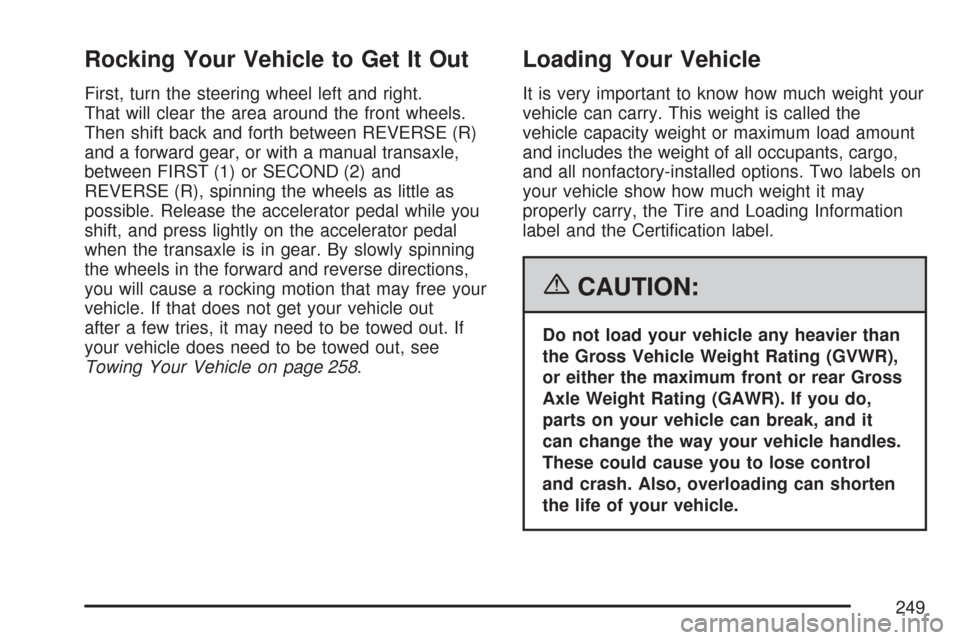
Rocking Your Vehicle to Get It Out
First, turn the steering wheel left and right.
That will clear the area around the front wheels.
Then shift back and forth between REVERSE (R)
and a forward gear, or with a manual transaxle,
between FIRST (1) or SECOND (2) and
REVERSE (R), spinning the wheels as little as
possible. Release the accelerator pedal while you
shift, and press lightly on the accelerator pedal
when the transaxle is in gear. By slowly spinning
the wheels in the forward and reverse directions,
you will cause a rocking motion that may free your
vehicle. If that does not get your vehicle out
after a few tries, it may need to be towed out. If
your vehicle does need to be towed out, see
Towing Your Vehicle on page 258.
Loading Your Vehicle
It is very important to know how much weight your
vehicle can carry. This weight is called the
vehicle capacity weight or maximum load amount
and includes the weight of all occupants, cargo,
and all nonfactory-installed options. Two labels on
your vehicle show how much weight it may
properly carry, the Tire and Loading Information
label and the Certification label.
{CAUTION:
Do not load your vehicle any heavier than
the Gross Vehicle Weight Rating (GVWR),
or either the maximum front or rear Gross
Axle Weight Rating (GAWR). If you do,
parts on your vehicle can break, and it
can change the way your vehicle handles.
These could cause you to lose control
and crash. Also, overloading can shorten
the life of your vehicle.
249
Page 328 of 436
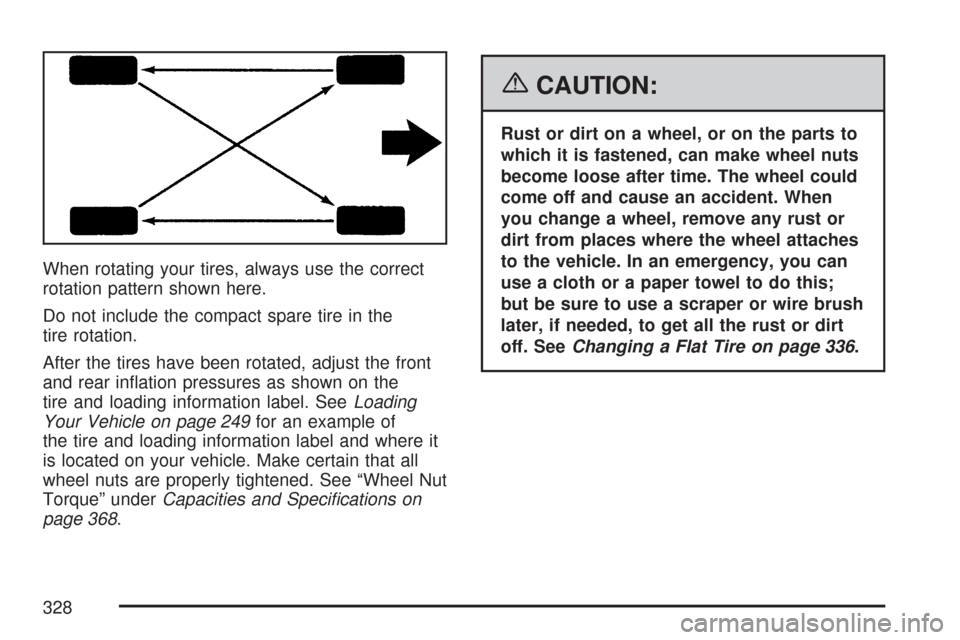
When rotating your tires, always use the correct
rotation pattern shown here.
Do not include the compact spare tire in the
tire rotation.
After the tires have been rotated, adjust the front
and rear inflation pressures as shown on the
tire and loading information label. SeeLoading
Your Vehicle on page 249for an example of
the tire and loading information label and where it
is located on your vehicle. Make certain that all
wheel nuts are properly tightened. See “Wheel Nut
Torque” underCapacities and Specifications on
page 368.
{CAUTION:
Rust or dirt on a wheel, or on the parts to
which it is fastened, can make wheel nuts
become loose after time. The wheel could
come off and cause an accident. When
you change a wheel, remove any rust or
dirt from places where the wheel attaches
to the vehicle. In an emergency, you can
use a cloth or a paper towel to do this;
but be sure to use a scraper or wire brush
later, if needed, to get all the rust or dirt
off. SeeChanging a Flat Tire on page 336.
328
Page 335 of 436
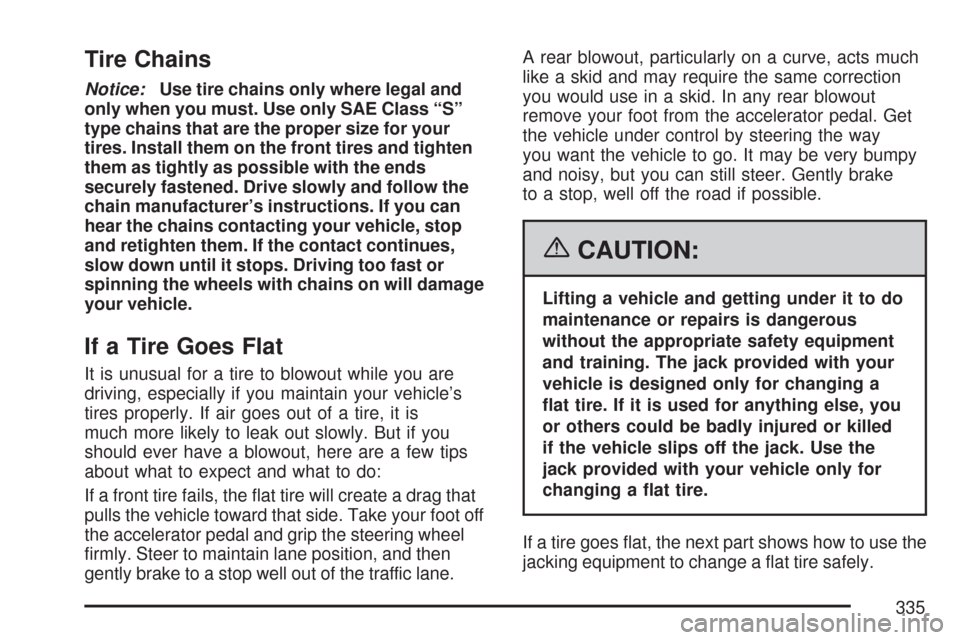
Tire Chains
Notice:Use tire chains only where legal and
only when you must. Use only SAE Class “S”
type chains that are the proper size for your
tires. Install them on the front tires and tighten
them as tightly as possible with the ends
securely fastened. Drive slowly and follow the
chain manufacturer’s instructions. If you can
hear the chains contacting your vehicle, stop
and retighten them. If the contact continues,
slow down until it stops. Driving too fast or
spinning the wheels with chains on will damage
your vehicle.
If a Tire Goes Flat
It is unusual for a tire to blowout while you are
driving, especially if you maintain your vehicle’s
tires properly. If air goes out of a tire, it is
much more likely to leak out slowly. But if you
should ever have a blowout, here are a few tips
about what to expect and what to do:
If a front tire fails, the flat tire will create a drag that
pulls the vehicle toward that side. Take your foot off
the accelerator pedal and grip the steering wheel
firmly. Steer to maintain lane position, and then
gently brake to a stop well out of the traffic lane.A rear blowout, particularly on a curve, acts much
like a skid and may require the same correction
you would use in a skid. In any rear blowout
remove your foot from the accelerator pedal. Get
the vehicle under control by steering the way
you want the vehicle to go. It may be very bumpy
and noisy, but you can still steer. Gently brake
to a stop, well off the road if possible.
{CAUTION:
Lifting a vehicle and getting under it to do
maintenance or repairs is dangerous
without the appropriate safety equipment
and training. The jack provided with your
vehicle is designed only for changing a
�at tire. If it is used for anything else, you
or others could be badly injured or killed
if the vehicle slips off the jack. Use the
jack provided with your vehicle only for
changing a �at tire.
If a tire goes flat, the next part shows how to use the
jacking equipment to change a flat tire safely.
335
Page 336 of 436
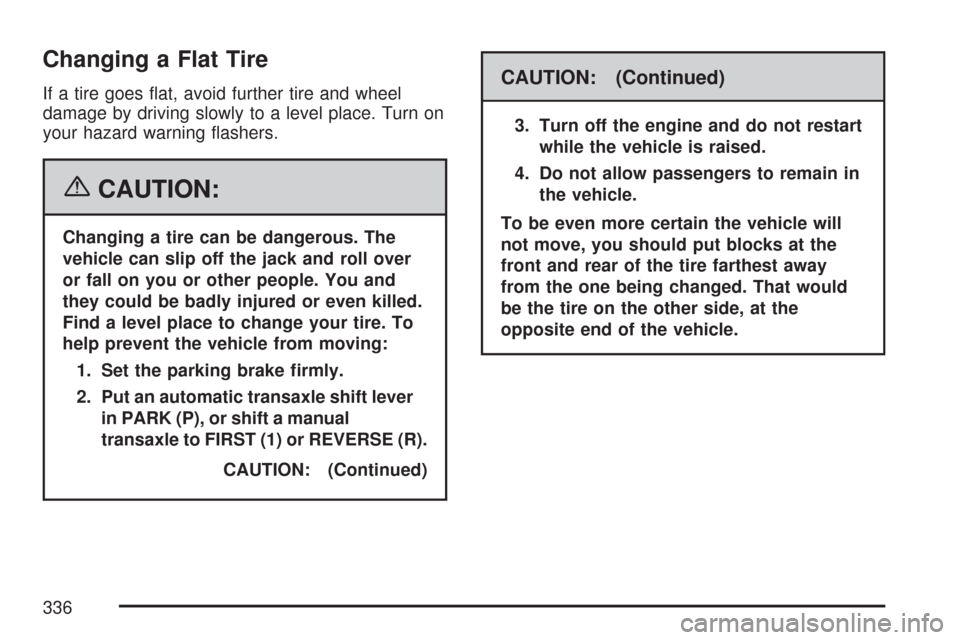
Changing a Flat Tire
If a tire goes flat, avoid further tire and wheel
damage by driving slowly to a level place. Turn on
your hazard warning flashers.
{CAUTION:
Changing a tire can be dangerous. The
vehicle can slip off the jack and roll over
or fall on you or other people. You and
they could be badly injured or even killed.
Find a level place to change your tire. To
help prevent the vehicle from moving:
1. Set the parking brake �rmly.
2. Put an automatic transaxle shift lever
in PARK (P), or shift a manual
transaxle to FIRST (1) or REVERSE (R).
CAUTION: (Continued)
CAUTION: (Continued)
3. Turn off the engine and do not restart
while the vehicle is raised.
4. Do not allow passengers to remain in
the vehicle.
To be even more certain the vehicle will
not move, you should put blocks at the
front and rear of the tire farthest away
from the one being changed. That would
be the tire on the other side, at the
opposite end of the vehicle.
336
Page 337 of 436
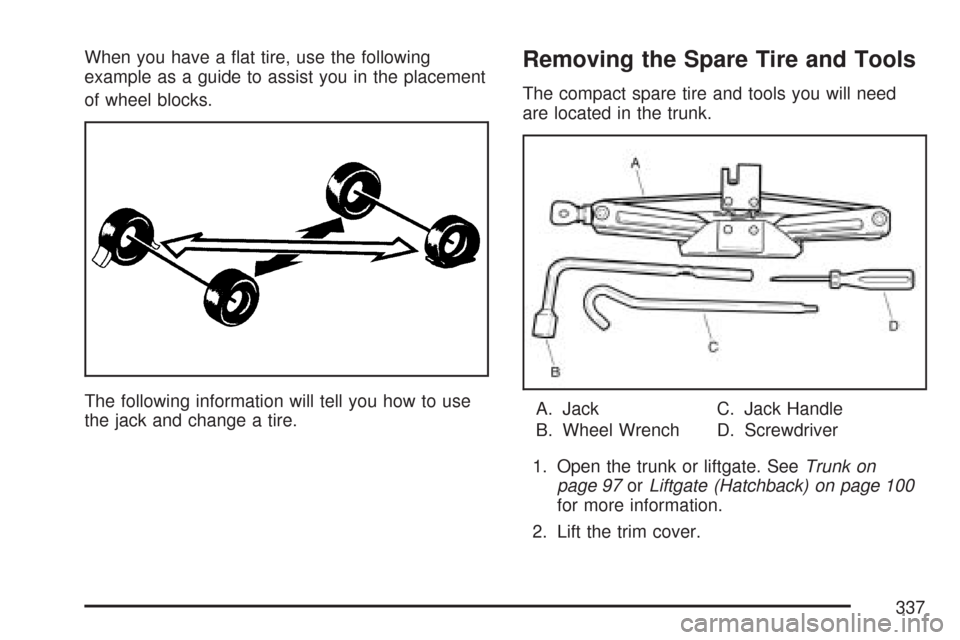
When you have a flat tire, use the following
example as a guide to assist you in the placement
of wheel blocks.
The following information will tell you how to use
the jack and change a tire.Removing the Spare Tire and Tools
The compact spare tire and tools you will need
are located in the trunk.
A. Jack
B. Wheel WrenchC. Jack Handle
D. Screwdriver
1. Open the trunk or liftgate. SeeTrunk on
page 97orLiftgate (Hatchback) on page 100
for more information.
2. Lift the trim cover.
337
Page 434 of 436

Service (cont.)
California Proposition 65 Warning............. 265
Doing Your Own Work............................. 265
Engine Soon Light...........................166, 180
Publications Ordering Information............. 420
Servicing Your Airbag-Equipped Vehicle......... 82
Sheet Metal Damage................................... 351
Shifting Into Park (P)................................... 118
Shifting Out of Park (P)............................... 120
Short Trip/City Scheduled Maintenance........ 376
Shoulder Belt Height Adjuster........................ 33
Signals, Turn and Lane-Change.................. 138
Spare Tire
Compact.................................................. 344
Installing.................................................. 339
Removing................................................ 337
Storing..................................................... 344
Specifications, Capacities............................ 368
Speedometer............................................... 159
Starting Your Engine................................... 109
Steering...................................................... 228
Steering, Suspension and Front Drive
Axle Boot and Seal Inspection................. 394
Steering Wheel Controls, Audio................... 215
Steering Wheel, Tilt Wheel.......................... 136Storage Areas............................................. 126
Cupholder(s)............................................ 127
Glove Box................................................ 127
Sunglasses Storage Compartment............ 127
Stuck in Sand, Mud, Ice, or Snow............... 248
Sun Visors.................................................. 103
Sunroof....................................................... 128
T
Tachometer................................................. 159
Taillamps
Turn Signal, Stoplamps and Back-up
Lamps.................................................. 316
Theft-Deterrent System................................ 103
Theft-Deterrent Systems.............................. 103
Immobilizer.............................................. 106
Immobilizer Operation.............................. 106
Tilt Wheel.................................................... 136
Time ........................................................... 149
Tires........................................................... 319
Aluminum Wheels, Cleaning..................... 350
Buying New Tires..................................... 330
Chains..................................................... 335
Changing a Flat Tire................................ 336
434
Page 435 of 436
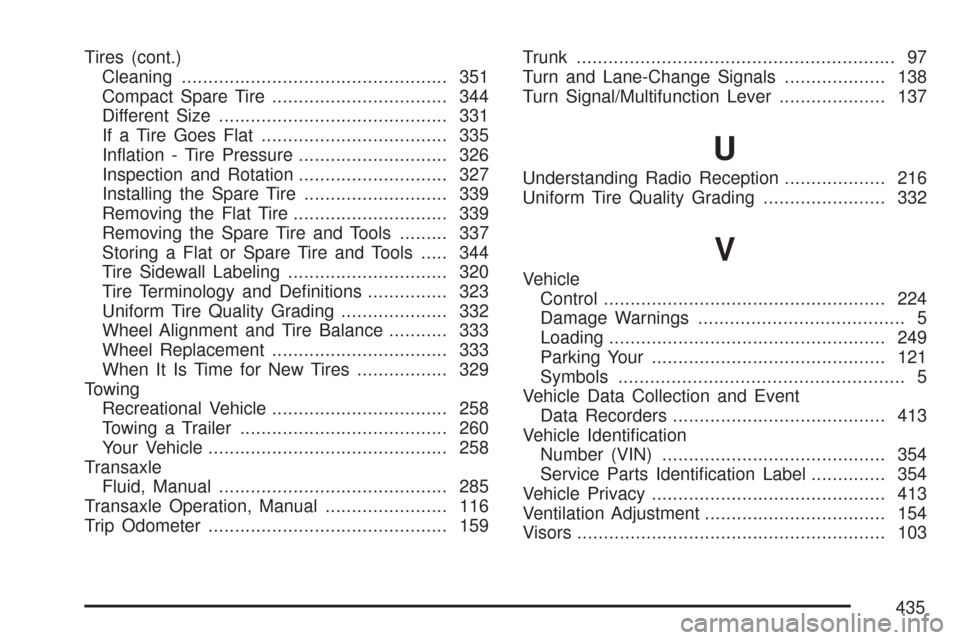
Tires (cont.)
Cleaning.................................................. 351
Compact Spare Tire................................. 344
Different Size........................................... 331
If a Tire Goes Flat................................... 335
Inflation - Tire Pressure............................ 326
Inspection and Rotation............................ 327
Installing the Spare Tire........................... 339
Removing the Flat Tire............................. 339
Removing the Spare Tire and Tools......... 337
Storing a Flat or Spare Tire and Tools..... 344
Tire Sidewall Labeling.............................. 320
Tire Terminology and Definitions............... 323
Uniform Tire Quality Grading.................... 332
Wheel Alignment and Tire Balance........... 333
Wheel Replacement................................. 333
When It Is Time for New Tires................. 329
Towing
Recreational Vehicle................................. 258
Towing a Trailer....................................... 260
Your Vehicle............................................. 258
Transaxle
Fluid, Manual........................................... 285
Transaxle Operation, Manual....................... 116
Trip Odometer............................................. 159Trunk............................................................ 97
Turn and Lane-Change Signals................... 138
Turn Signal/Multifunction Lever.................... 137
U
Understanding Radio Reception................... 216
Uniform Tire Quality Grading....................... 332
V
Vehicle
Control..................................................... 224
Damage Warnings....................................... 5
Loading.................................................... 249
Parking Your............................................ 121
Symbols...................................................... 5
Vehicle Data Collection and Event
Data Recorders........................................ 413
Vehicle Identification
Number (VIN).......................................... 354
Service Parts Identification Label.............. 354
Vehicle Privacy............................................ 413
Ventilation Adjustment.................................. 154
Visors.......................................................... 103
435